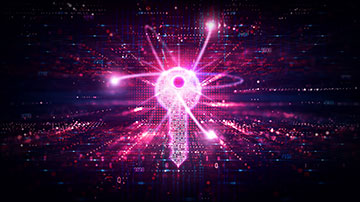
Record breaker: suppressing the system noise in a lab-based experiment has enabled researchers to distribute quantum keys over a distance of more than 1000 km. [Image: ArtemisDiana / Getty Images]
A team of researchers led by Jian-Wei Pan of the University of Science and Technology of China (USTC) has for the first time distributed secure quantum keys over an optical link longer than 1000 km (Phys. Rev. Lett., doi: 10.1103/PhysRevLett.130.210801). Breaking the previous record of 830 km for a lab-based experiment, the team combined a specific protocol that has previously been shown to extend the range of quantum key distribution (QKD) with an optical setup that suppresses system noise through the use of bespoke single-photon detectors and a novel phase-stabilization technique.
Minimizing noise and loss
QKD systems provide ultrasecure communications between two distinct locations by generating and distributing secure keys at a higher rate than is possible with conventional numerical methods. However, the transmission distance that can be achieved with QKD technology is limited by system noise and photon losses within the fiber. As a result, today’s commercial systems can only operate over distances of up to around 100 km.
To overcome this distance barrier, the group exploited a breakthrough scheme called twin-field QKD, which researchers at Toshiba showed in 2018 can effectively double the transmission distance while maintaining the same secret-key rate. The new work adopts the sending-or-not-sending (SNS) variant of the twin-field protocol, along with additional techniques to correct for errors and improve the secure-key rate.
Breaking the distance record also required the researchers to identify and remove all sources of noise from their experimental setup. They contend that most of the noise within the fiber channel is caused by spontaneous Raman scattering, which they reduced by developing a novel technique for dual-band phase estimation—which is needed in twin-field QKD protocols to stabilize the phase—that relies on data postprocessing rather than active phase modulators and real-time feedback circuits.
This combination of noise-canceling measures enabled the team to send secure keys over 1002 km of spooled fiber at a rate of 0.0034 bits per second.
The team also designed superconducting nanowire single-photon detectors that minimize the dark count noise generated by thermal radiation. Low-temperature filters operating at 40 K and 2.2 K were incorporated into the devices, reducing the dark count rate from about 10 Hz to around 0.02 Hz. Meanwhile, photon loss along the transmission path was minimized by using ultralow-loss fiber based on so-called pure-silica-core technology, which provides an average attenuation of less than 0.16 dB/km.
More than 1000 km
This combination of noise-canceling measures enabled the team to send secure keys over 1002 km of spooled fiber at a rate of 0.0034 bits per second. Optimizing the experimental parameters for shorter links delivered a secure key rate of more than 47 kbit/s over a distance of 200 km, confirming that the scheme can achieve high key rates in a practical scenario.
According to a press release, the latest work opens up new possibilities for long-distance quantum key distribution and paves the way for the realization of high-speed intercity quantum communication networks.

